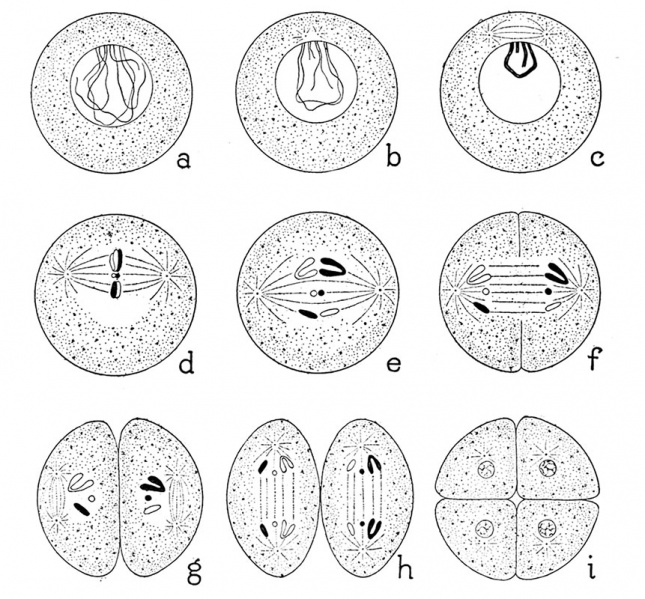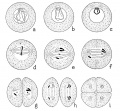File:Morgan 1925 fig34.jpg

Original file (861 × 800 pixels, file size: 182 KB, MIME type: image/jpeg)
Fig, 34. Diagram illustrating the two maturation divisions of the germ cells in the male
In a the chromosomes appear as thin threads (leptotene stage). These conjugate in pairs, b, beginning at the two ends of each loop.
The threads contract, and a spindle appears, d, near the nucleus. The conjugating chromosomes enter the spindle, d. There they separate, e, moving to opposite poles of the spindle. The cell protoplasm begins to constrict, f.
The chromosomes may without entering upon a resting nuclear stage pass onto a new spindle that has developed by the division of each of the centrosomes of each daughter cell, g. Each chromosome now splits throughout its length (equational division) ; half of each goes to one or the other pole. The two daughter cells then divide, giving four cells, each of which differentiates into a spermatozoon.
| Historic Disclaimer - information about historic embryology pages |
|---|
| Pages where the terms "Historic" (textbooks, papers, people, recommendations) appear on this site, and sections within pages where this disclaimer appears, indicate that the content and scientific understanding are specific to the time of publication. This means that while some scientific descriptions are still accurate, the terminology and interpretation of the developmental mechanisms reflect the understanding at the time of original publication and those of the preceding periods, these terms, interpretations and recommendations may not reflect our current scientific understanding. (More? Embryology History | Historic Embryology Papers) |
Reference
Morgan, T. H. (1925). Evolution and genetics. Princeton: Princeton University Press.
Cite this page: Hill, M.A. (2024, April 20) Embryology Morgan 1925 fig34.jpg. Retrieved from https://embryology.med.unsw.edu.au/embryology/index.php/File:Morgan_1925_fig34.jpg
- © Dr Mark Hill 2024, UNSW Embryology ISBN: 978 0 7334 2609 4 - UNSW CRICOS Provider Code No. 00098G
File history
Click on a date/time to view the file as it appeared at that time.
| Date/Time | Thumbnail | Dimensions | User | Comment | |
|---|---|---|---|---|---|
| current | 09:08, 23 October 2014 |  | 861 × 800 (182 KB) | Z8600021 (talk | contribs) | |
| 09:07, 23 October 2014 |  | 1,200 × 1,442 (399 KB) | Z8600021 (talk | contribs) | {{Morgan1925_figures}} |
You cannot overwrite this file.
File usage
The following 2 pages use this file:
